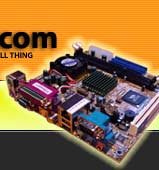|
5 Atom Mini-ITX Boards Reviewed
Sandra CPU Benchmarks
Benchmarks do not always represent true real-life performance, but they are still extremely useful to compare systems. Sisoft's Sandra is the industry standard diagnostic, analysis and testing package. We'll just use the ALU and FPU benchmarks in our test, and other tools to build a wider picture.
The Dhrystone benchmark measures CPU performance using a standardised sample of mainly numerical operations. The result is given in MIPS (Million Instructions Per Second). The Whetstone benchmark measures FPU (Floating Point) performance, although many modern processors have a number of newer features such as out-of-order execution, pipelining and SSE2 which are not tested using this benchmark. In this test, bigger is better.
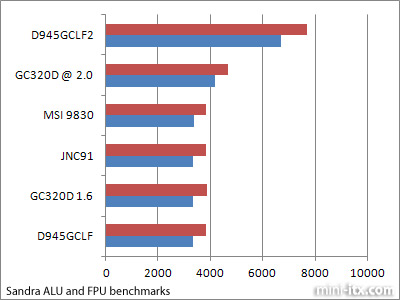
All the 1.6GHz Atom boards performed identically, achieving on average 3840 ALU and 3340 FPU. The overclocked GA-GC230D reached 4657 and 4181 but the standout here was the Dual Core Atom board with 7693 and 6703.
wPrime32 - calculating prime numbers with multiple CPUs
Next we chose wPrime32, a multithreaded version of superpi. The Atom CPU was too new to be detected correctly so we chose 4 CPUs for the Dual Core and 2 CPUs for the others, to give the best results. Hyper Threading was enabled on all boards by default giving 2 effective CPUs for each core. We weren't expecting the sub 10 second wPrime32 scores that hundreds of dollars of CPU can buy - this is a low end showdown after all.
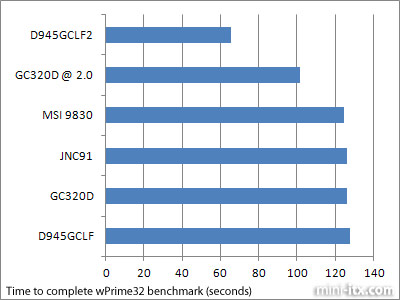
The standard 1.6GHz boards calculated Pi in between 124 and 127 seconds, with the overclocked GA-GC230D managing 101 seconds and the Dual Core Atom managing 65 seconds.
MediaEncoder - encoding video with multiple CPUs
MediaEncoder is an excellent freeware application that encodes video into a variety of formats using all the available CPUs on a system. We re-encoded 1 minute of MPEG4 video using the default settings.
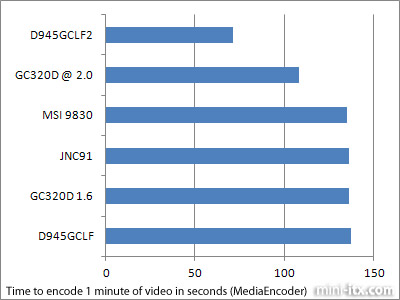
We're starting to see a pattern here. The standard boards encoded in 135-137 seconds, the overclocked GA-GC230D in 108 seconds and the Dual Core Atom encoded in 71 seconds.
PCMark2005 a 'real world' benchmark
PCMark2005 is another standard benchmark designed to perform 'real world' tasks to give an idea of the speed of a system. We're not so sure about the usefulness of this benchmark, but you'll complain if we don't include it. So here it is. This was the only benchmark that performed any graphical tests.

The results are much closer together here, with one anomaly. The MSI board results weren't quite comparable to the other 1.6GHz boards either due to the slightly different chipset, or the lack of correct graphics drivers, or a combination of the two. The difference wasn't huge however. Interestingly, the Dual Core board and the overclocked GA-GC230D both achieved the same scores on this one. Full results: D945GCLF: 1641; GC230D: 1622; JNC91: 1658; MS-9830: 1499; GC230D @ 2.0GHz: 1928; D945GCLF2: 1929.
Idle and Load Power Draw
Of much more interest to us is measuring the power draw of each board when idle and under load. This was done with a standard socket type household energy meter, and an AC Adapter and DC Converter combination exactly as found at the Mini-ITX Store.
Our reasoning for not using a larger ATX power supply was twofold:
1. Our results would be increased by at least 10W to 15W simply because of the inefficiencies of the ATX PSU at such a low current.
2. The large majority of Mini-ITX cases do not use ATX PSUs at all - they use AC Adapters and DC Converters, which are designed to efficiently deliver small amounts of power. Really we should measure the current draw at 3V, 5V and 12V with shunts and an oscilloscope and calculate the total power usage, but we'll leave that for another day. We're probably accurate to within +/-2W of the 'correct' figures. Measuring the power consumption of Mini-ITX boards with an ATX PSU simply isn't meaningful at all. If any print or web reviewers want us to send them an AC Adapter and DC Converter for a discounted price, contact the Mini-ITX store...
Idle and Load Power Draw - booting from USB Memory Stick
We booted Ubuntu 8.04 from USB memory stick and measured the idle power draw, then stressed the CPU of each board to get a loaded reading. This gave the range we could reasonably expect each board to work within when booting from increasingly popular solid state memory.
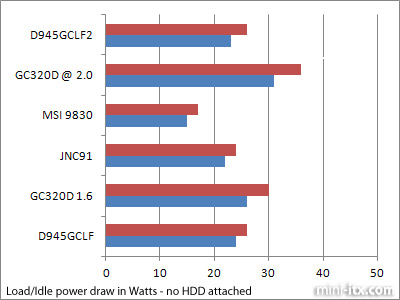
The MSI with its low power chipset was the clear winner here, at just 15W-17W in use. The Dual Core Intel D945GCLF2 performed similarly to the single core Intel and better than the single core Gigabyte board, which drew a little more than the others (and even more when overclocked).
| D945 GCLF | GC230D | JNC91 | MSI 9830 | GC230D @ 2.0 | D945 GCLF2 |
| Idle (W) | 24 | 26 | 22 | 15 | 31 | 23 |
| Load (W) | 26 | 30 | 24 | 17 | 36 | 26 |
Idle and Load Power Draw - booting from 3.5in Hard Drive
For our final test we booted Windows XP from a 3.5in Hard Drive and stressed the CPUs again. This gave us a working range for a typical system (most Mini-ITX systems use slimline optical drives if they use an optical drive at all, and in fact plenty use 2.5in Hard Drives).
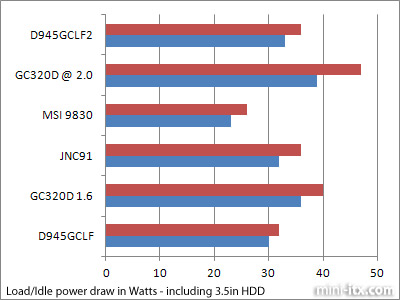
The results are as we would expect, as our 3.5in Hard Drive draws around 8W-10W. A 2.5in Hard Drive would have only added about 1-2W to the previous figures.
| D945 GCLF | GC230D | JNC91 | MSI 9830 | GC230D @ 2.0 | D945 GCLF2 |
| Idle (W) | 30 | 36 | 32 | 23 | 39 | 33 |
| Load (W) | 32 | 40 | 36 | 26 | 47 | 36 |
Video Playback -->
*Advert* Find your perfect board the Mini-ITX store! *Advert*
Our board finder will help you decide at the Mini-ITX.com Online Store. We serve the UK, Europe, USA and beyond. Order in-stock components before 7.00PM GMT and we'll ship same day! |
|
|

